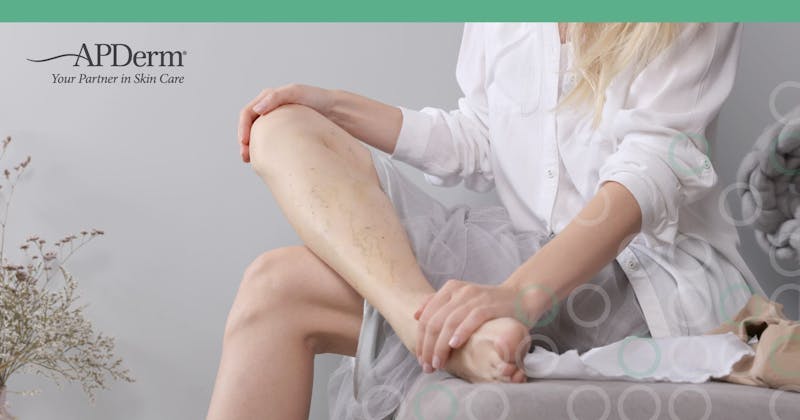Your Family Deserves the Best Care Book an Appointment
Your skin health matters, so don’t delay. Our clinicians look forward to treating you and your family at one of our local New England practices.
Find Your Nearest APDerm Center
Spider veins can be annoying and unsightly, but they usually aren’t a sign of a more serious medical condition. Still, many men and women want their spider veins to go away for cosmetic reasons, and they are difficult to treat without seeking dermatological care.
If you’re feeling self-conscious or refuse to wear shorts due to spider veins, it may be time to discuss your concerns with a dermatologist. Veins can become more noticeable as you age and your skin gets thinner. However, these blue-and-purple weblike lines can appear during any season of life.
Getting rid of spider veins can boost your confidence, reveal clearer skin, and make you feel younger. There are ways to say goodbye to your spider veins.
Spider veins get their name due to the way they look. These small, thin veins appear in the outer layer of skin between the dermis and epidermis, which makes them more visible. They may be red or purple and spread out in clusters, resembling a spider’s web. They often develop on the face, ankles, and legs, often behind the knee, but they can show up anywhere on the body.
Venous insufficiency is one cause of spider veins and deeper varicose veins. A disruption in the natural flow of blood can cause veins to bulge and become visible underneath the skin. A valve problem can cause blood to flow in the wrong direction and get backed up in the veins of the leg. The extra pressure can damage the walls of the vein, causing them to weaken, bulge, and rise to the surface over time.
Other causes of spider veins include:
There are a few lifestyle changes you can make to help prevent veins from developing:
If you sit at a desk all day at work, aim to get up and walk every 30 or 60 minutes. Conversely, if you stand for long periods, try taking regular breaks to rest your legs.
In most cases, spider vein treatment involves medical intervention and surgical methods. Your dermatologist can discuss the various treatment options. There are several safe and effective ways to treat spider and varicose veins.
This minimally invasive treatment injects a solution, typically a salt solution, directly into the affected veins. The solution irritates the lining of the vessels and causes the vein walls to close and collapse. That helps redirect the blood through healthy veins, and the treated veins are reabsorbed by the body.
Sclerotherapy is one of the least invasive methods to reduce visible veins. Other benefits include:
After treatment, patients are encouraged to go for a daily walk to promote circulation and prevent blood clots. Compression stockings also are recommended to help reduce the treated veins and prevent spider veins from returning.
This method uses a laser treatment to heat the vein, so it will contract and scar over. Some smaller spider veins can be treated using a small handheld laser that’s used for laser hair removal. For deeper varicose veins, the procedure may require a catheter to insert the laser to stop blood flow.
While most treatments are effective, you may need several sclerotherapy treatments and follow up treatments every one to two years. Once the spider veins are closed off or removed, they can reappear in other areas. If left untreated, they can multiply.
Regardless of what option you choose, it’s important to seek out a qualified doctor who specializes in vein treatments. Schedule an appointment with your dermatologist to discuss your concerns, the severity of the problem, possible underlying conditions, and the best options for your situation.
APDerm offers a variety of medical, cosmetic, and surgical dermatology services backed by a team of skincare experts and board-certified dermatologists. Contact APDerm today to schedule a consultation and discuss the best option to treat your spider and varicose veins without surgery or downtime.